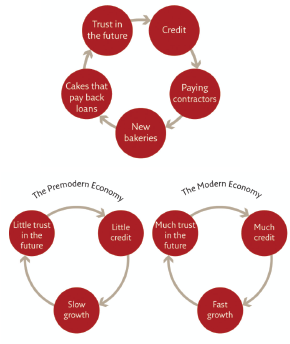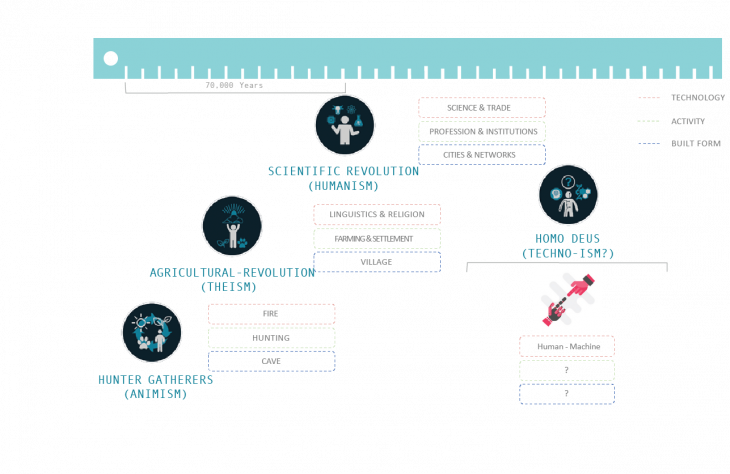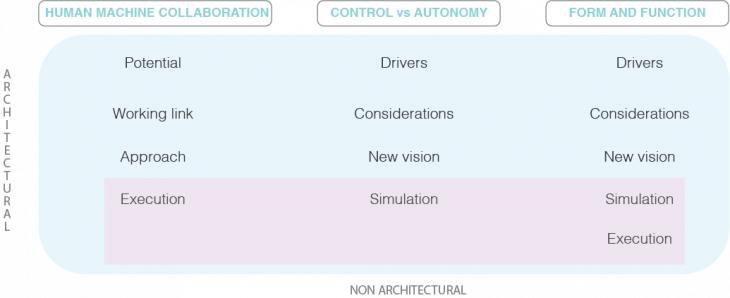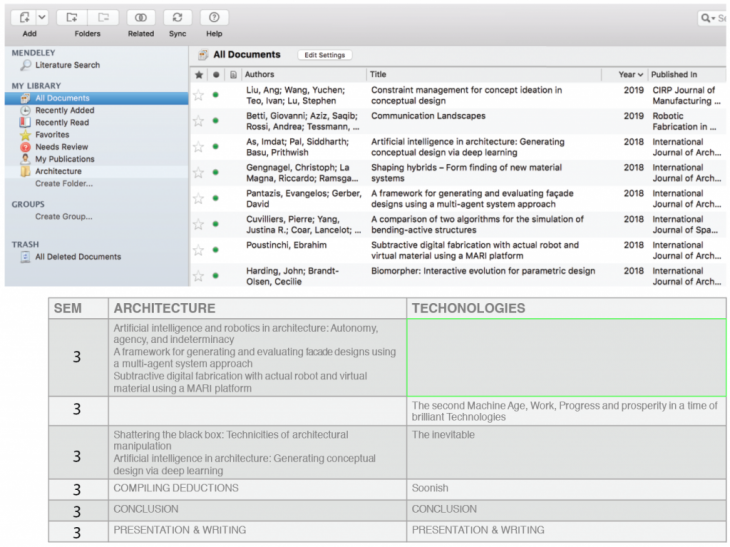RESEARCH PROBLEM
The contemplation of the human-machine collaboration and its potential in revolutionising the field of of architecture is highly anticipated, discussed, and sought out, yet the exact form and function of it is either in the form of scattered research or novels that fail to collaborate all the viable research; lacking a balance between research and vision to inform the audience. For example, in the works of Yuval Noah Harari the added description of future technologies, to speculate the change of humanity is based on Technology so far and study of human habitation and lifestyle as a major means of study; but lacks to describe the form and function of human-machine architecture, as compared to, desperation of technology, capitalism, medicine, anthropology, sociology and many other fields which can be used to help define future architecture.

Harari’s representation of growth in any industry

Diagram representing uncertainty in the field of architectural growth
HYPOTHESIS
Architecture or built forms are a reflection of our activities as they are shaped by them. Deciding where we lead emergent technologies can indicate systemic abilities for goal setting and operational strategy concepts closely associated not only with the performative aspects of architectural interventions but also with the nature of the techniques and tools that produce them.These terms might imply an enhanced relationship between architecture, its inhabitants, and its environment; a complex link between architecture, its production, and its tools; or a capacity of architecture to produce new conditions and grounds on which it could be engaged. This issue takes a closer look at artificial intelligence (AI) and human-machine collaboration in architecture.
Application of technology in the AEC industry is undergoing tremendous research, but is not out reached as the other fields. One of the main reasons for growth in technology in every other field in comparison to the AEC industry is due to the lack of motivation or collaboration, this is mainly because the plausibility of growing architectural research in making a change is a foreign topic to most common people. Breakthroughs in machine and deep learning have produced computational tools capable of interpreting only structured data, bits, pixels, and vectors. These systems are capable of becoming incrementally more robust and autonomous over time as they gather more information reinforcing success and failure.
In other territories, disciplines, and frontiers, AI advances are met with both excitement and trepidation. Their application threatens one of two polemics: augmentation or obsolescence.The possibilities and ramifications for more creative, artistic, or even “human” disciplines—where outputs are not linear or pre-conceived but negotiated and synthesised—are more contested and unknown. The power and potential of such approaches lies in their lack of specificity. The contributions to this explore a spectrum of novel design explorations and exploitations that illustrates the divergence and convergence of human, machine, and mixed agencies at the intersection with adaptivity, adjustable autonomy, and architecture.

Diagram representing similarities within different fields of research
HUMAN-MACHINE COLLABORATION
Architectural
• Potential – misbehavior analignment between intentions and design outcomes.
• Working link – unexpected and the indeterminate.
• Active approach – designing, evaluating, and materializing architecture, collaborating and partnering with our tools. • Execution – enactive process, adapting their collective actions to the requirements of their situation.
• Machine (Tehnical Agent) – Human (Information) – As this process matures, delineations between virtual and physical become blurred.
• Evolution of tools > Emancipication – “A Framework for Generating and Evaluating Façade Designs Using a Multi-Agent Systems Approach” by Evangelos Pantazis and David Gerber.
Non architectural
• Evolution of tools > Emancipication (within gaming to Siri/Alexa) – the communication and collaboration between humans, devices, machines,and systems enable a shared learning process and the establishment of collective knowledge.
CONTROL VERSUS AUTONOMY
Architectural
• Drivers – degree to which information gathering and processing is impacting design workflows.
• Considerations – Functional organization, behavior, utility, and aesthetics are considered in relation to each other.
• New vision – as an integrative tool of active production not only of material conditions but of new forms of information.
• Execution – interdependent associations between hardware, software, and ideas. • Simulating > real-life conditions – “Subtractive Digital Fabrication with Actual Robot and Virtual Material Using a MARI Platform” by Ebrahim Poustinchi.
Non architectural
• Simulating > Opportunity – “Digital Provenance and Material Metadata: Attribution and Co-Authorship in the Age of Artificial Intelligence” by Shelby Doyle and Nick Senske.
REFRAMING FORM AND FUNCTION
Architectural
• Drivers – qualitative versus quantitative interplay elicits new dimensions of agency.
• Utilty, functionality and poetic > Learnig (served|servant) – “Shattering the Black Box: Technicities of Architectural Manipulation” by Stavros Kousoulas.
• Considerations – technical solution > feedback < creative process
• New vision – promise enhanced performance through their emancipation from previous dependencies. • Simuating > Form to Function (interdependant) – “Artificial Intelligence in Architecture: Generating Conceptual Design via Deep Learning” by Imdat As, Siddharth Pal, and Prithwish Basu.
• Execution – programmable adjacencies and dispositions, as well as latent poetic and uplifting parameters.
Non architectural
• Simuating > Form to Function (independant) – “Digital Provenance and Material Metadata: Attribution and Co-Authorship in the Age of Artificial Intelligence” by Shelby Doyle and Nick Senske.
• Analytics > new representational language – “Deep Learning in Design Workflows—The Elusive Design Pixel” by Ranjeeth Mahankali, Brian Johnson, and Alex Anderson.
WORKPLAN

BIBLIOGRAPHY
NON ARCHITECTURAL
[1] LG. Caldas, An evolution-based generative design system: using adaptation to shape architectural form, Ph.D. Dissertation in Architecture: Building Technology, MIT, 2001. [2] N. Bouchlaghen, Optimising the design of building envelopes for thermal performance, Automation in Construction 10 (2000) 101– 112. [3] M. Wetter, J. Wright, A comparison of deterministic and probabilistic optimization algorithms for nonsmooth simulation-based optimisation, Building and Environment 39 (8) (2004) 989–999. [4] J. Horn, N. Nafpliotis, D. Goldberg, Niched Pareto genetic algorithm for multiobjective optimization, in: Proceedings of the 1st IEEE Conference on Evolutionary Computation, Part 1, June 27–29, Orlando, FL, 1994, pp. 82–87. [5] “Christopher Steiner, Automate This: How Algorithms Came to Rule Our World (New York: Penguin, 2012), 215; Tom Vanderbilt, ‘Let the Robot Drive: The Autonomous Car of the Future Is Here’, Wired, 20 January 2012, accessed 21 December 2014,Chris Urmson, ‘The Self-Driving Car Logs More Miles on New Wheels’, Google Official Blog, 7 August 2012, accessed 23 December 2014,
http://googleblog.blogspot.hu/2012/08/the-self-driving-car-logs-more-miles-on.html;
Matt Richtel and Conor Dougherty, ‘Google’s Driverless Cars Run into Problem: Cars with Drivers’, New York Times, 1 September 2015, accessed 2 September 2015,
From: Yuval Noah Harari. “Sapiens and Homo Deus.” iBooks. [6] “Robin Dunbar, Grooming, Gossip, and the Evolution of Language (Cambridge, MA: Harvard University Press, 1998)”Excerpt From: Yuval Noah Harari. “Sapiens and Homo Deus.” iBooks. [7] “Fekri A. Hassan, ‘Holocene Lakes and Prehistoric Settlements of the Western Fayum, Egypt’, Journal of Archaeological Science 13:5 (1986), 393–504; Gunther Garbrecht, ‘Water Storage (Lake Moeris) in the Fayum Depression, Legend or Reality?’, Irrigation and Drainage Systems 1:3 (1987), 143–57; Gunther Garbrecht, ‘Historical Water Storage for Irrigation in the Fayum Depression (Egypt)’, Irrigation and Drainage Systems 10:1 (1996), 47–76.”Excerpt From: Yuval Noah Harari. “Sapiens and Homo Deus.” iBooks. [8] “See, for example, Kevin Kelly, What Technology Wants (New York: Viking Press, 2010); César Hidalgo, Why Information Grows: The Evolution of Order, from Atoms to Economies (New York: Basic Books, 2015); Howard Bloom, Global Brain: The Evolution of Mass Mind from the Big Bang to the 21st Century (Hoboken: Wiley, 2001); DuBravac, Digital Destiny.”Excerpt From: Yuval Noah Harari. “Sapiens and Homo Deus.” iBooks. [9] “William H. McNeill and J. R. McNeill, The Human Web: A Bird’s-Eye View of World History (New York: W. W. Norton, 2003)”Excerpt From: Yuval Noah Harari. “Sapiens and Homo Deus.” iBooks. [10] “No More Woof’,
https://www.indiegogo.com/projects/no-more-woof.”Excerpt
From: Yuval Noah Harari. “Sapiens and Homo Deus.” iBooks. [11] “The map is based mainly on: Peter Bellwood, First Farmers: The Origins of Agricultural Societies (Malden: Blackwell Publishing, 2005).”Excerpt From: Yuval Noah Harari. “Sapiens and Homo Deus.” iBooks. [12] “Jared Diamond, Guns, Germs, and Steel: The Fates of Human Societies (New York: W. W. Norton, 1997).”Excerpt From: Yuval Noah Harari. “Sapiens and Homo Deus.” iBooks. [13] “Gross Domestic Product 2009’, the World Bank, Data and Statistics, accessed 10 December 2010,
http://siteresources.worldbank.org/DATASTATISTICS/Resources/GDP.pdf.”Excerpt
From: Yuval Noah Harari. “Sapiens and Homo Deus.” iBooks. [14] “Mark, Origins of the Modern World, 81”Excerpt From: Yuval Noah Harari. “Sapiens and Homo Deus.” iBooks. [15] “Christian, Maps of Time, 436.”Excerpt From: Yuval Noah Harari. “Sapiens and Homo Deus.” iBooks. [16] “Georges Nzongola-Ntalaja, The Congo from Leopold to Kabila: A People’s History (London: Zed Books, 2002), 22.”Excerpt From: Yuval Noah Harari. “Sapiens and Homo Deus.” iBooks. [17]“Kazuhisa Miyamoto (ed.), ‘Renewable Biological Systems for Alternative Sustainable Energy Production’, FAO Agricultural Services Bulletin 128 (Osaka: Osaka University, 1997), Chapter 2.1.1, accessed 10 December 2010,
http://www.fao.org/docrep/W7241E/w7241e06.htm#2.1.1percent20solarpercent20energy;
James Barber, ‘Biological Solar Energy’, Philosophical Transactions of the Royal Society A 365:1853 (2007), 1007.”Excerpt From: Yuval Noah Harari. “Sapiens and Homo Deus.” iBooks. [18] “G. J. Benson and B. E. Rollin (eds.), The Well-being of Farm Animals: Challenges and Solutions (Ames, IA: Blackwell, 2004); M. C. Appleby, J. A. Mench and B. O. Hughes, Poultry Behaviour and Welfare (Wallingford: CABI Publishing, 2004); J. Webster, Animal Welfare: Limping Towards Eden (Oxford: Blackwell Publishing, 2005); C. Druce and P. Lymbery, Outlawed in Europe: How America is Falling Behind Europe in Farm Animal Welfare (New York: Archimedean Press, 2002).”Excerpt From: Yuval Noah Harari. “Sapiens and Homo Deus.” iBooks. [19] “Vaclav Smil, The Earth’s Biosphere: Evolution, Dynamics and Change (Cambridge, Mass.: MIT Press, 2002); Sarah Catherine Walpole et al., ‘The Weight of Nations: An Estimation of Adult Human Biomass’, BMC Public Health 12:439 (2012),
http://www.biomedcentral.com/1471–2458/12/439.”Excerpt
From: Yuval Noah Harari. “Sapiens and Homo Deus.” iBooks. [20] “Ya-Ping Tang et al., ‘Genetic Enhancement of Learning and Memory in Mice’, Nature 401 (1999), 63–”Excerpt From: Yuval Noah Harari. “Sapiens and Homo Deus.” iBooks. [21] “Hybrid Insect Micro Electromechanical Systems (HI-MEMS)’, Microsystems Technology Office, DARPA, accessed 22 March 2012,
http://www.darpa.mil/Our_Work/MTO/Programs/Hybrid_Insect_Micro_Electromechanical_Systems_percent28HI-MEMSpercent29.aspx.
See also: Sally Adee, ‘Nuclear-Powered Transponder for Cyborg Insect’, IEEE Spectrum, December 2009, accessed 10 December 2010,
http://spectrum.ieee.org/semiconductors/devices/nuclearpowered-transponder-for-cyborg-insect?utm_source=feedburner&utm_medium=feed&utm_campaign=Feedpercent3A+IeeeSpectrum+percent28IEEE+Spectrumpercent29&utm_content=Google+Reader;
Jessica Marshall, ‘The Fly Who Bugged Me’, New Scientist 197:2646 (2008), 40–3; Emily Singer, ‘Send in the Rescue Rats’, New Scientist 183:2466 (2004), 21–2; Susan Brown, ‘Stealth Sharks to Patrol the High Seas’, New Scientist 189:2541 (2006), 30–1.”Excerpt From: Yuval Noah Harari. “Sapiens and Homo Deus.” iBooks. [22] “Hybrid Insect Micro Electromechanical Systems (HI-MEMS)’, Microsystems Technology Office, DARPA, accessed 22 March 2012,
http://www.darpa.mil/Our_Work/MTO/Programs/Hybrid_Insect_Micro_Electromechanical_Systems_percent28HI-MEMSpercent29.aspx.
See also: Sally Adee, ‘Nuclear-Powered Transponder for Cyborg Insect’, IEEE Spectrum, December 2009, accessed 10 December 2010,
http://spectrum.ieee.org/semiconductors/devices/nuclearpowered-transponder-for-cyborg-insect?utm_source=feedburner&utm_medium=feed&utm_campaign=Feedpercent3A+IeeeSpectrum+percent28IEEE+Spectrumpercent29&utm_content=Google+Reader;
Jessica Marshall, ‘The Fly Who Bugged Me’, New Scientist 197:2646 (2008), 40–3; Emily Singer, ‘Send in the Rescue Rats’, New Scientist 183:2466 (2004), 21–2; Susan Brown, ‘Stealth Sharks to Patrol the High Seas’, New Scientist 189:2541 (2006), 30–1.”Excerpt From: Yuval Noah Harari. “Sapiens and Homo Deus.” iBooks.
ARCHITECTURAL
Afsari, K., Eastman, C. and Shelden, D. (2017) ‘Building Information Modeling data interoperability for Cloud-based collaboration: Limitations and opportunities’, International Journal of Architectural Computing, 15(3), pp. 187–202. doi: 10.1177/1478077117731174. Altov, H. (Altshuller) (1994) And suddenly the inventor appeared. Technical Innovation Center. Aradau, C. and Blanke, T. (2015) ‘The (Big) Data-security assemblage: Knowledge and critique’, Big Data & Society, 2(2), p. 205395171560906. doi: 10.1177/2053951715609066. Aris, I. Bin and Iqbal, A. K. M. P. (2006) ‘Design and Fabrication of a Cartesian Painter Robot for the Construction Industry’, International Journal of Mechanical Engineering Education, 34(2), pp. 125–144. doi: 10.7227/IJMEE.34.2.3. Aryadoust, V. (2013) ‘Predicting item difficulty in a language test with an adaptive neuro fuzzy inference system’, in 2013 IEEE Workshop on Hybrid Intelligent Models and Applications (HIMA). IEEE, pp. 43–50. doi: 10.1109/HIMA.2013.6615021. As, I., Pal, S. and Basu, P. (2018) ‘Artificial intelligence in architecture: Generating conceptual design via deep learning’, International Journal of Architectural Computing. SAGE PublicationsSage UK: London, England, 16(4), pp. 306–327. doi: 10.1177/1478077118800982. Badhrinath, K. and Jagannatha Rao, J. R. (1996) ‘Modeling for Concurrent Design Using Game Theory Formulations’, Concurrent Engineering, 4(4), pp. 389–399. doi: 10.1177/1063293X9600400407. Bahdanau, D., Cho, K. and Bengio, Y. (2014) ‘Neural Machine Translation by Jointly Learning to Align and Translate’. Available at:
http://arxiv.org/abs/1409.0473
(Accessed: 12 March 2019). Barnes, M. R. (1999) ‘Form Finding and Analysis of Tension Structures by Dynamic Relaxation’, International Journal of Space Structures, 14(2), pp. 89–104. doi: 10.1260/0266351991494722. Bertilsson, T. M. (2004) ‘The Elementary Forms of Pragmatism’, European Journal of Social Theory, 7(3), pp. 371–389. doi: 10.1177/1368431004044199. Betti, G. et al. (2019) ‘Communication Landscapes’, in Robotic Fabrication in Architecture, Art and Design 2018. Cham: Springer International Publishing, pp. 74–84. doi: 10.1007/978-3-319-92294-2_6. Bras, B. and Mistree, F. (1994) ‘Concurrent Axiomatic and Robust Design using Compromise Decision Support Problems’, Concurrent Engineering, 2(1), pp. 17–31. doi: 10.1177/1063293X9400200103. Caldas, L. G. and Norford, L. K. (2003) ‘Shape Generation Using Pareto Genetic Algorithms: Integrating Conflicting Design Objectives in Low-Energy Architecture’, International Journal of Architectural Computing, 1(4), pp. 503–515. doi: 10.1260/147807703773633509. Chaitanya Chaduvula, S., Atallah, M. J. and Panchal, J. H. (2018) ‘Secure Codesign: Achieving Optimality Without Revealing’, Journal of Computing and Information Science in Engineering, 18(2), p. 021007. doi: 10.1115/1.4039431. Chang, K.-H. et al. (1998) ‘A Multilevel Product Model for Simulation-Based Design of Mechanical Systems’, Concurrent Engineering, 6(2), pp. 131–144. doi: 10.1177/1063293X9800600204. Chaszar, A. and Joyce, S. C. (2016) ‘Generating freedom: Questions of flexibility in digital design and architectural computation’, International Journal of Architectural Computing, 14(2), pp. 167–181. doi: 10.1177/1478077116638945. Chen, L., Pu, J. and Wang, X. (2002) ‘A general model for machinable features and its application to machinability evaluation of mechanical parts’, Computer-Aided Design, 34(3), pp. 239–249. doi: 10.1016/S0010-4485(01)00085-9. Chen, S.-J. and Lin, L. (2002) ‘A Project Task Coordination Model for Team Organization in Concurrent Engineering’, Concurrent Engineering, 10(3), pp. 187–202. doi: 10.1177/106329302761689115. Cuvilliers, P. et al. (2018) ‘A comparison of two algorithms for the simulation of bending-active structures’, International Journal of Space Structures. SAGE PublicationsSage UK: London, England, 33(2), pp. 73–85. doi: 10.1177/0266351118779979. Dade-Robertson, M. (2013) ‘Architectural User Interfaces: Themes, Trends and Directions in the Evolution of Architectural Design and Human Computer Interaction’, International Journal of Architectural Computing, 11(1), pp. 1–19. doi: 10.1260/1478-0771.11.1.1. Davis, D. (2014) ‘Quantitatively Analysing Parametric Models’, International Journal of Architectural Computing, 12(3), pp. 307–319. doi: 10.1260/1478-0771.12.3.307. Derix, C. (2009) ‘In-Between Architecture Computation’, International Journal of Architectural Computing, 7(4), pp. 565–585. doi: 10.1260/1478-0771.7.4.565. Ding, L. et al. (2009) ‘An Information Support Approach for Machine Design & Building Companies’, Concurrent Engineering, 17(2), pp. 103–109. doi: 10.1177/1063293X09105325. Ding, L. and Matthews, J. (2009) ‘A contemporary study into the application of neural network techniques employed to automate CAD/CAM integration for die manufacture’, Computers & Industrial Engineering, 57(4), pp. 1457–1471. doi: 10.1016/j.cie.2009.01.006. Doyle, S. and Senske, N. (2018) ‘Digital provenance and material metadata: Attribution and co-authorship in the age of artificial intelligence’, International Journal of Architectural Computing. SAGE PublicationsSage UK: London, England, 16(4), pp. 271–280. doi: 10.1177/1478077118800887. Duarte, J. P. (2005) ‘Towards the Mass Customization of Housing: The Grammar of Siza’s Houses at Malagueira’, Environment and Planning B: Planning and Design, 32(3), pp. 347–380. doi: 10.1068/b31124. Faircloth, B. et al. (2018) ‘Multiscale modeling frameworks for architecture: Designing the unseen and invisible with phase change materials’, International Journal of Architectural Computing, 16(2), pp. 104–122. doi: 10.1177/1478077118778599. Feenberg, A. L. (2017) ‘Concretizing Simondon and Constructivism’, Science, Technology, & Human Values, 42(1), pp. 62–85. doi: 10.1177/0162243916661763. Ford, D. N. and Sterman, J. D. (2003) ‘Overcoming the 90% Syndrome: Iteration Management in Concurrent Development Projects’, Concurrent Engineering, 11(3), pp. 177–186. doi: 10.1177/106329303038031. Gengnagel, C. et al. (2018) ‘Shaping hybrids – Form finding of new material systems’, International Journal of Architectural Computing. SAGE PublicationsSage UK: London, England, 16(2), pp. 91–103. doi: 10.1177/1478077118778587. Gero, J. S. and Sosa, R. (2008) ‘Complexity Measures as a Basis for Mass Customization of Novel Designs’, Environment and Planning B: Planning and Design, 35(1), pp. 3–15. doi: 10.1068/b32106. Grover, A. and Leskovec, J. (2016) ‘node2vec’, in Proceedings of the 22nd ACM SIGKDD International Conference on Knowledge Discovery and Data Mining – KDD ’16. New York, New York, USA: ACM Press, pp. 855–864. doi: 10.1145/2939672.2939754. Gu, P., Xue, D. and Nee, A. Y. C. (2009) ‘Adaptable design: Concepts, methods, and applications’, Proceedings of the Institution of Mechanical Engineers, Part B: Journal of Engineering Manufacture, 223(11), pp. 1367–1387. doi: 10.1243/09544054JEM1387. Hague, M. J. and Taleb-Bendiab, A. (1998) ‘Tool for the Management of Concurrent Conceptual Engineering Design’, Concurrent Engineering. Sage PublicationsSage CA: Thousand Oaks, CA, 6(2), pp. 111–129. doi: 10.1177/1063293X9800600203. Harding, J. and Brandt-Olsen, C. (2018) ‘Biomorpher: Interactive evolution for parametric design’, International Journal of Architectural Computing. SAGE PublicationsSage UK: London, England, 16(2), pp. 144–163. doi: 10.1177/1478077118778579. Hashemian, M. and Gu, P. (1995) ‘A Constraint-Based System for Product Design’, Concurrent Engineering. Sage PublicationsSage CA: Thousand Oaks, CA, 3(3), pp. 177–186. doi: 10.1177/1063293X9500300303.
STUDENT: Owaze Ansari.